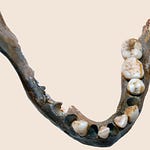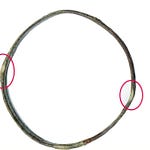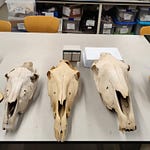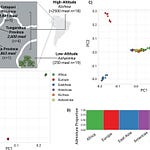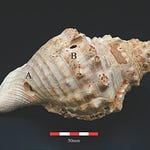Piecing Together an Ancient Puzzle
Buried in the rocky sediments of South Africa’s Drimolen Main Quarry lies the fossil of a partial pelvis—small, fragile, and easily overlooked. But this ancient bone, designated DNH 43, dates back nearly 2 million years and offers a rare glimpse into the anatomy of our distant relatives.
The pelvis—made up of the sacrum and parts of the hip bone—is one of the most informative parts of the skeleton for understanding locomotion and childbirth in human evolution. Yet, complete or even partially articulated pelvises are rare in the fossil record. What makes DNH 43 especially valuable is not just its age but how its dimensions connect it to both the past and future of hominin form.
"The fossil is best attributed to Paranthropus robustus and displays an overall primitive, gracile morphology," the researchers1 write, “but presents with positioning of the sacrum similar to that of recent humans.”
This strange mix of the archaic and the modern invites new thinking about how early hominins moved, gave birth, and adapted to their landscapes.
Hips Don’t Lie: The Form and Function of DNH 43
Excavated at the Drimolen site in Gauteng Province, DNH 43 was found in a region that also yielded the earliest Homo erectus fossils known in South Africa. This pelvic fossil likely belonged to Paranthropus robustus, a robust-toothed hominin adapted to chewing hard plant matter. The authors stress that taxonomic attribution remains cautious—early Homo is also found at the site—but they lean toward Paranthropus based on anatomy and context.
Digital reconstruction and 3D modeling revealed that DNH 43 had:
A small sacrum (lower back base) with features more like Australopithecus than later Homo
A relatively narrow sacral plate, compressed front to back
Gracile, lightly built hip bones
A sacral tilt (pelvic incidence) of 56°, remarkably similar to modern Homo sapiens
"These data suggest spinopelvic mechanics in Australopithecus (and likely Paranthropus if DNH 43 indeed represents the genus) were similar to recent Homo sapiens in how they positioned the torso and head over the hip joint during bipedal posture and locomotion."
That’s a significant departure from previous ideas that early hominin pelvises lacked the curvature necessary for modern upright walking. DNH 43's pelvic tilt points to a more advanced spinal alignment than previously recognized in hominins this old.
Obstetrics in the Deep Past
One of the evolutionary challenges faced by our lineage is the so-called "obstetric dilemma"—balancing efficient bipedalism with the need to give birth to increasingly larger-brained babies. DNH 43 provides important clues.
The pelvis is mediolaterally wide, especially between the hip joints (biacetabular breadth) and at the narrowest point of the birth canal (bispinous breadth). Indexed against the size of the hip socket, these values suggest an exceptionally spacious pelvic outlet, a feature that might reflect a non-rotational birth mechanism, similar to that inferred for Australopithecus.
“The exceptionally wide bispinous and biacetabular breadths of DNH 43 suggest a capacious pelvic outlet that might indicate a non-rotational birth mechanism.”
Yet this does not appear to compromise locomotion. A broader pelvis could help early hominins maintain stride length with shorter legs—possibly by relying more on pelvic rotation rather than long strides. And according to the authors, such an arrangement may not significantly increase energy cost while walking.
Paranthropus or Early Homo?
Here’s the catch: despite the pelvis’s primitive features, it’s not entirely clear whether DNH 43 belonged to Paranthropus robustus or a very early member of Homo. Fossils of early Homo from South Africa are sparse and fragmentary, especially postcranially. Some pelvic traits in DNH 43 align more with Homo, including the pelvic incidence and certain aspects of the sacroiliac articulation. But others are more consistent with Paranthropus or Australopithecus.
The researchers emphasize that early Homo, Paranthropus, and Australopithecus overlapped chronologically and probably retained a great deal of shared ancestral anatomy.
“Basal members of Homo might be difficult to identify based solely on the pelvic traits visible in DNH 43,” they note. “Consequently, taxonomic assignment of postcranial remains such as DNH 43 may be subject to revision.”
The Many Shapes of Being Human
If anything, DNH 43 reinforces the idea that early human evolution wasn’t a straight line. Instead, it was a mosaic—a patchwork of ancient and novel traits, expressed in ways that don’t always conform to tidy categories.
A pelvis that resembles both Paranthropus and Homo, and allows for both efficient walking and a spacious birth canal, speaks to the diversity and flexibility of hominin evolution. These were creatures negotiating life on a landscape that demanded endurance, adaptation, and reproduction—all with the tools nature gave them.
One pelvis at a time, we're learning that being human has always come in many forms.
Related Research
Here are additional studies that deepen context for DNH 43 and early pelvic evolution:
Anton, S.C. & Middleton, E.R. (2023). Making meaning from fragmentary fossils: Early Homo in the Early to early Middle Pleistocene. Journal of Human Evolution, 179, 103307. https://doi.org/10.1016/j.jhevol.2022.103307
Churchill, S.E., et al. (2018). The pelvis of Australopithecus sediba. PaleoAnthropology, 2018:334–356. https://doi.org/10.4207/PA.2018.ART116
Simpson, S.W., et al. (2008). A female Homo erectus pelvis from Gona, Ethiopia. Science, 322(5904):1089–1092. https://doi.org/10.1126/science.1163592
VanSickle, C., et al. (2018). Homo naledi pelvic remains from the Dinaledi Chamber, South Africa. Journal of Human Evolution, 125, 122–136. https://doi.org/10.1016/j.jhevol.2017.10.001
Been, E., et al. (2013). Sacral orientation in hominin evolution. Advances in Anthropology, 3(3):133–141. https://doi.org/10.4236/aa.2013.33018
Berg, E., Hammond, A. S., Warrener, A. G., Shirley Mitchell, M., Tocheri, M. W., Baker, S. E., Herries, A. I. R., Strait, D. S., & Orr, C. M. (2025). Further assessment of a ~2-million-year-old hominin pelvis (DNH 43) from Drimolen Main Quarry, South Africa. South African Journal of Science, 121(3/4). https://doi.org/10.17159/sajs.2025/17908



